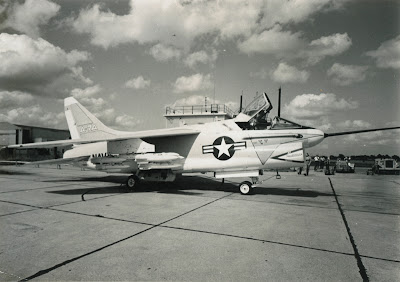 |
| The first YA-7A, BuNo 152580 in late 1965. The triangular area under the refueling probe as well as on the vertical tail are painted flight test orange. |
And then there's the story of the enormously successful LTV A-7 Corsair II,which was conceived of by the Navy as a ground-attack aircraft replacement for the A-4 Skyraider. Due to cost concerns, the Navy wanted a plane based on a previous design, rather than what was perceived as a more-expensive clean-sheet approach. Vought, Douglas (with an enlarged A-4), Grumman (a single-seat variant of the A-6) and North American (TF-1E Fury) all submitted proposals.
With the Ling-TEMCO-Vought conglomerate’s F-8 Crusader-based design as the selected winner, the Navy ordered a prototype, six more as flight test aircraft, and 35 production aircraft on March 19, 1964. Ultimately, the first three were also referred to as YA-7A.
The A-7 was similar to the F-8 Crusader in appearance, but ultimately was its own aircraft, shorter and stubbier, plus specifically designed to be subsonic, whereas the Crusader was supersonic. The logic was that by not wasting fuel on the afterburner or fuselage space on area ruling, both required to go Mach speeds, the A-7 could carry more payload farther, even if it was a bit slower - and boy, could it do that: three times the payload of the Crusader! The A-7 could be armed to the teeth with a wide-combination of ground attack munitions on six wing-mounted hard points, plus two additional side-fuselage hard points for Sidewinders. It also sported a pair of 20mm cannon, which were later replaced by a single 6-barrel 20mm Gatling gun.
The first aircraft was BuNo 152580 and is the subject of today's featured photo. It was rolled out on August 13, 1965, and the maiden flight took place on September 27th at the Dallas Naval Air Station with LTV test pilot John Konrad at the controls. Its career did not last long, however. On March 23, 1966, LTV test pilot John Omvig was doing touch-and-goes at NAS China Lake, and on final approach, inadvertently switched off the aircraft's hydraulics system. Without the hydraulically actuated flight control system, the aircraft began to roll inverted. As 152580 rolled through the 90 degree point, Omvig ejected, but at very low altitude - witnesses later said that he was only at telephone pole height when his chute opened, and he was badly hurt upon landing. The aircraft crashed and was destroyed on the base's golf course, about three miles from the end of the runway. (Omvig wasn't so lucky the next time...just over a year later, on May 10, 1967, he was killed in the crash of an XC-142A)
Given that it only flew for six months, and the non-desert environs depicted in our feature photo, it is like that the photo was taken very soon after its first flight, while it was still at Vought's Dallas facility. The "Corsair II" name was selected in November, 1965, and at some point lettering to that affect was added below the "A-7A" on the tail, so the photo was probably taken in October or November.
Despite the loss of the first aircraft, what resulted from the program was a robust aircraft that even the Air Force ended up buying, and a warfighter that served in Vietnam, Grenada, Libya and even Iraq during Desert Storm before the last American one was retired in 1993 (the Greek Air Force continued to use the A-7 in limited roles into the 21st Century).
The older designations are properly written F4U and O2U, for what it's worth.
ReplyDeleteGreat blog - keep it coming!
The A-7 was the first plane to take off from a carrier carrying a payload which weighed more than the aircraft itself. This plane was a real workhorse during Vietnam.
ReplyDeleteThanks for the pictures and memories.
Alan is simply the best at taking an unnamed, unplaced image and giving the lost picture a "thousand words".
ReplyDeleteEric
This and the F-8 and other planes from the era sort of remind me old muscle cars. They just look fast and powerful. Why is the pitot tube so long on the nose?
ReplyDeleteDale...virtually all first-article flight test aircraft have a "flight test pitot", which samples air farther out in front, and is thus used to calibrate the accuracy of the production pitot location.
ReplyDelete